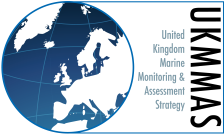Biological effects (EROD enzyme activity) in fish
The assessment shows that since 2012, flatfish are exposed to some polycyclic aromatic hydrocarbons, polychlorinated biphenyls, furans and dioxins in the Celtic Seas and Greater North Sea sub-regions, but these do not induce significant 7-ethoxyresorufin O-deethlyation (EROD) enzyme activity. There is no evidence of systematic exposure at the regional level. Recent trends have been mainly downward or stable. Currently, there is no upper-threshold for EROD activity that indicates whether significant harm to sea life has occurred, so assessing progress towards the target has not been possible.
Background
UK target on biological effects (EROD enzyme activity) in fish
This indicator is used to supplement the target for biological effects of contaminants set out in the Marine Strategy Part One (HM Government, 2012), which requires that for biological effects “the intensity of those biological or ecological effects due to contaminants agreed by OSPAR as appropriate for MSFD purposes are below the toxicologically-based standards”. Whilst this indicator has not yet been agreed by OSPAR for Marine Strategy Framework Directive (European Commission, 2008) purposes, it provides some information on the exposure of fish to several contaminants and therefore has been included in the assessment of Good Environmental Status for contaminants.
Key pressures and impacts
In the UK Initial Assessment (HM Government, 2012), the key pressures associated with this indicator were riverine and direct inputs of legacy contaminants arising from point and diffuse sources, atmospheric and acute events that have entered marine sediments, which can then accumulate in fish and increase the activity of detoxification enzymes. These are still relevant.
Measures taken to address the impacts
There is a robust UK legislative framework in place for controlling and reducing pollution from contaminants, including appropriate consenting and monitoring programmes, which is described in the UK Marine Strategy Part Three (HM Government, 2015). However, many of the determinands fish are exposed to entered the sea before the controls were put in place and, due to their persistence, are still present. Removing these from the sea is not considered to be a practicable option.
Monitoring, assessment and regional cooperation
Areas that have been assessed
Status and trend assessments were conducted for the UK portion of the Greater North Sea and Celtic Seas Marine Strategy Framework Directive (European Commission, 2008) sub-regions, and at the smaller scale of the 8 UK biogeographic marine regions set out in Charting Progress 2 (UKMMAS, 2010).
Monitoring and assessment methods
The activity of the detoxification enzyme 7-ethoxy-resorufin-O-deethylase (EROD) is used in biomonitoring studies as a measure of exposure to hazardous substances. Risk-based monitoring and assessment of the status and trends of activity of EROD in fish was conducted within the annual UK Clean Seas Environmental Monitoring Programme using methods and principles set out in the OSPAR Coordinated Environmental Monitoring Programme. The assessment analysed both status and trend results of individual monitoring stations and synthesised the result to assess trends on the biogeographic regional level.
Assessment thresholds
Most biological effects are OSPAR candidate indicators because not all countries use them in environmental monitoring. OSPAR has developed species-specific Background Assessment Criteria but no Environmental Assessment Criteria (OSPAR Commission, 2009) to assess the activity of EROD in fish liver. OSPAR has an aspirational ultimate objective to achieve the background concentrations which naturally occur in the marine environment and whilst the target was not described in the UK Marine Strategy Part One (HM Government, 2012), the status and trend results were used to examine progress towards this objective.
Regional co-operation
Although this is not an OSPAR indicator, the UK and OSPAR are working together in the development, monitoring and assessment of this indicator.
Further information
As stated in the Marine Strategy Part One (HM Government, 2012): “Contaminants can enter the marine environment from natural sources and as a result of anthropogenic activities, either as direct inputs or via rivers, estuaries and the atmosphere. Pollution is considered to be the introduction of substances which have, or are likely to have, deleterious effects on the marine environment and its uses. This includes effects that result in harm to the health of aquatic organisms, loss of biodiversity, chemicals hazardous to human health, impair water quality, or reduce our ability to use the sea. “
7-ethoxy-resorufin-O-deethylase (EROD) is an enzyme found in fish liver, which is important in the metabolism of contaminants such as certain polycyclic aromatic hydrocarbons and other structurally similar compounds. The expression and activity of EROD increases in fish exposed to these contaminants through the food they eat, contact with contaminated sediments or their presence in water column.
The measurement of EROD activity in the liver of fish is useful for biomonitoring purposes because its expression and activity can increase upon the exposure of fish to contaminants that bind to the aryl hydrocarbon receptor and stimulate the induction of CYP1A enzyme activity. These substances include some polycyclic aromatic hydrocarbons, planar polychlorinated biphenyls, dibenzo-p-furans and dibenzo-p-dioxins, many of which are readily metabolised and excreted by fish, meaning that exposure cannot be reliably determined by analytical chemical methods. The induction of CYP1A can lead to the production of genotoxic metabolites (particularly those formed after the biotransformation of polycyclic aromatic hydrocarbons) and consequently it can be used as an indicator of adverse effects in exposed animals. In support of this, there is a considerable amount of field evidence correlating CYP1A induction with DNA damage, chemical carcinogenesis and other pathological conditions in marine organisms (ICES, 2011). The concentrations of hazardous substances have long been monitored in flatfish as part of the UK marine monitoring programme. The additional use of biological effects monitoring allows the exposure of organisms to compounds that are metabolised and excreted to be observed and provides an integrative measure of exposure to mixtures of contaminants with the same mode of action (that is aryl hydrocarbon-receptor binding). The UK has monitored EROD activity in the fish liver due to impacts of contaminants since 2000, as part of the routine annual monitoring surveys.
Within the United Kingdom, the Clean Seas Environment Monitoring Programme is one means by which our national and international commitments to monitor marine biota in near-shore and offshore marine waters are met (Nicolaus and others, 2016). The main drivers for the current programme are the Co-ordinated Environmental Monitoring Programme and Joint Assessment and Monitoring Programme of the OSPAR Convention (OSPAR Commission, 2014), together with the European Union Marine Strategy Framework Directive (European Commission, 2008) and Water Framework Directive (European Commission, 2000). Within the Clean Seas Environment Monitoring Programme, the UK monitors contaminants and their biological effects in flatfish (mainly dab but also flounder and plaice) from around British seas. This indicator (EROD activity in fish liver) is one of several used to assess progress against the target covering the biological effects of contaminants set out in the Marine Strategy Part One (HM Government, 2012). The determination of EROD activity gives a sensitive and integrated measure of exposure to hazardous substances that bind to the aryl hydrocarbon receptor of fish and provides information to assess progress towards this target. Clean Seas Environment Monitoring Programme monitoring and assessments are done at the scale of the 8 UK biogeographical marine regions that were defined in the Charting Progress 2 report on the status of the seas (UKMMAS, 2010).
Except for imposex, the biological effects methods are OSPAR Candidate Indicators, as not all countries use them in environmental monitoring. OSPAR has developed species-specific Background Assessment Criteria to assess EROD activity in fish liver. Below Background Assessment Criteria, the effects are deemed to be at a background level and the organisms are not significantly exposed to contaminants. OSPAR have not defined Environmental Assessment Criteria (OSPAR Commission, 2009) for use with this exposure indicator, which means that there is no upper-threshold for EROD activity that indicates significant environmental harm. The UK has also been active within OSPAR and ICES to develop an integrated assessment framework for contaminants and their biological effects (Davies and Vethaak, 2012; OSPAR Commission, 2016; Vethaak and others, 2017), including an extensive practical workshop to test this at the Regional Seas scale (Hylland and others, 2017a, Hylland and others, 2017b; Robinson and others, 2017; Vethaak and others, 2017).
Assessment method
Assessment methodology for 7- ethoxyresorufin O-deethylase activity in flatfish
The 2016 assessment of Clean Seas Environment Monitoring Programme data describes the trends and status of 7- ethoxyresorufin O-deethylase (EROD) activity in biota at monitoring stations around the UK. Assessments are made for many time series, each of a single determinand in a single species for either male or female at a single monitoring station. This section describes how the results of the individual time series are synthesised to assess status and trends at the biogeographic regional level. It considers EROD activity in biota.
The regional assessment only considers coastal and offshore stations and excludes estuarine stations. The results are therefore based on the monitoring data collected within the waters assessed under the Marine Strategy Framework Directive (European Commission, 2008) and are used as part of the UK’s assessment of Contaminants. Locations of monitoring stations where there are suitable data are shown in Figure 1. The number of time series in each biogeographic region is given in Table 1.
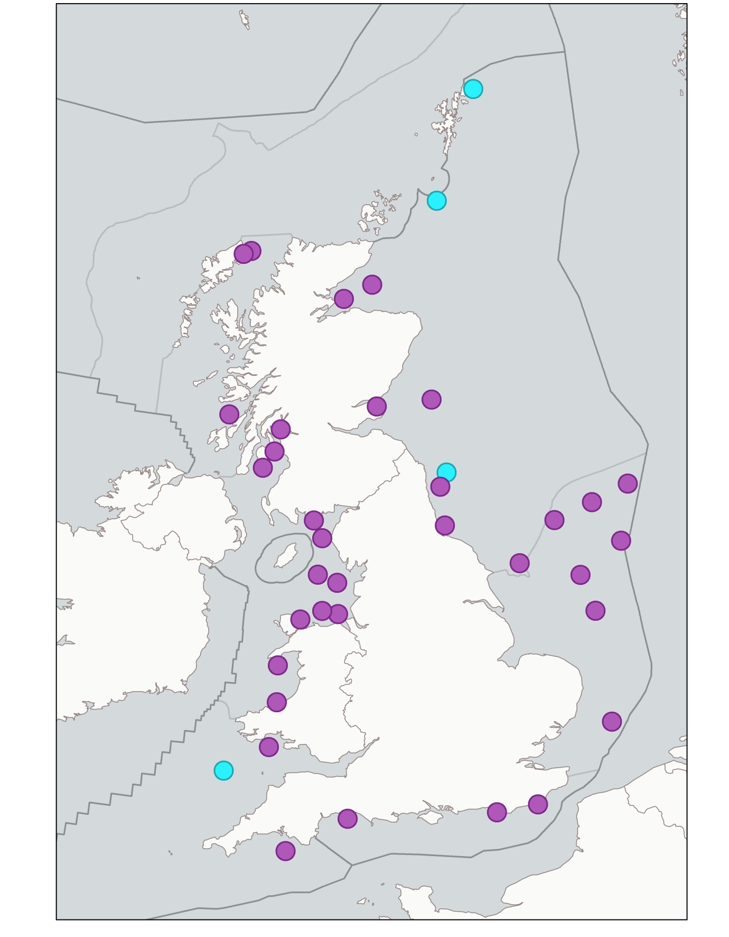
Figure 1. Trend and status (purple circles) and status only (blue circles) monitoring stations used to assess EROD activity in biota. The areas delineated by the thinner black lines are the biogeographic regions and those delineated by the thicker black lines are the Marine Strategy Framework (European Commission, 2008) Directive sub-regions.
Table 1. Number of time series within each sub-region used in the assessment of status and trends.
|
Marine Strategy Framework Directive sub-region |
Biogeographic region |
Status assessment |
Trend assessment |
|
Greater North Sea
|
Northern North Sea |
19 |
12 |
|
Southern North Sea |
14 |
14 |
|
|
E Channel |
6 |
6 |
|
|
Celtic Seas
|
Minches & W Scotland |
4 |
3 |
|
Irish Sea |
21 |
22 |
|
|
W Channel & Celtic Sea |
6 |
4 |
Areas that have been assessed
Status and trends assessments were conducted for the UK-portion of the Greater North Sea and Celtic Seas Marine Strategy Framework (European Commission, 2008) Directive sub-regions, and at the smaller scale of the 8 UK biogeographic marine regions set out in Charting Progress 2 (UKMMAS, 2010).
Assessment of EROD activity in flatfish
The concentrations of activity were monitored in fish liver. Samples were taken in annual monitoring surveys based on the sampling frequencies specified in the OSPAR Joint Assessment and Monitoring Programme guideline (OSPAR Commission, 2014). Sampling and chemical analysis methodologies met the relevant OSPAR requirements, whilst assessments of status and trends were also based on OSPAR methodologies. Males and females are assessed separately, as they have different assessment criteria (Table 2).
Table 2. OSPAR Background Assessment Criteria for the EROD activity in flatfish liver. Background Assessment Criteria are expressed as pmol min-1 mg S9 protein-1 (pico-mol per minute per milligram of S9 protein) or pmol min-1 mg microsomal protein-1 for the liver S9.
|
Species |
Latin name |
Sex |
Matrix |
Background Assessment Criteria |
|
Dab |
Limanda limanda |
Female |
Liver S9 |
178 |
|
Male |
Liver S9 |
147 |
||
|
Flounder |
Platichthys flesus |
Male |
Liver S9 |
24 |
|
Plaice |
Pleuronectes platessa |
Male |
Liver S9 |
9.5 |
The EROD activity measurement method was based on the ICES Techniques in Marine Environmental Sciences protocol (Stagg and others, 2016) with minor modifications. Briefly, an aliquot of liver is centrifuged at 10,000 × g and the CYP1A activity of the resultant S9 fraction determined fluorimetrically, as the catalytic conversion of ethoxyresorufin substrate to resorufin product. The measured activity is normalised for the protein content of the sample and report as picomoles of resorufin produced per minute per mg of protein (pMol min-1 mg-1).
UK monitoring data are submitted annually to the Marine Environment Monitoring and Assessment National database and to the International Council for the Exploration of the Seas Database on Oceanography and Marine Ecosystems. Monitoring data are assessed for status and trends following standard OSPAR approaches (Fryer and Nicolson, 1999). This indicator can only be assessed against Background Assessment Criteria and as there is no Environmental Assessment Criteria to indicate possible harmful impacts.
An individual time series of EROD activity is assessed for status if:
- there is at least one year with data in the period 2010 to 2015
- there are at least three years of data over the whole time-series
- a parametric model can be fitted to the data and used to estimate the mean activity in the final monitoring year (or, occasionally, if a non-parametric test of status is applied)
An individual time series is assessed for trends if:
- there is at least one year with data in the period 2010 to 2015
- there are at least five years of data over the whole time-series
- a parametric model can be fitted to the data and used to estimate the trend in mean activity
Information on how the individual time series as assessed for status and trends is available from the British Oceanographic Data Centre.
Assessment thresholds for EROD activity in flatfish
OSPAR Background Assessment Criteria for EROD activity have been developed for flounder (Platichthys flesus), dab (Limanda limanda) and plaice (Pleuronectes platessa, Table 2). Background Assessment Criteria were developed to test whether observed results are near background levels. As EROD activity is a non-monotonic response to exposure (that is, there is an inverted U-shaped response curve where high levels of exposure cause lower activity than “moderate” levels of exposure), it is not possible to define Environmental Assessment Criteria above which environmental harm may be occurring.
Results
Findings in the 2012 UK Initial Assessment
No initial assessment of 7-ethoxy-resorufin-O-deethylase (EROD) activity in flatfish liver was carried out in 2012 (HM Government, 2012).
Latest findings
Status assessment
There is currently no upper threshold for EROD activity. For the Greater North Sea and Celtic Seas, 67% and 68%, respectively, of the assessments were significantly below the Background Assessment Criteria, implying limited exposure to contaminants and therefore meeting the target described in the UK Marine Strategy Part One (HM Government, 2012) for this biological effects indicator (Figures 2 and 3). Overall, there is high confidence in this assessment but no confidence in whether the exposure is harmful at stations where the Background Assessment Criteria was breached due to the lack of an upper threshold.
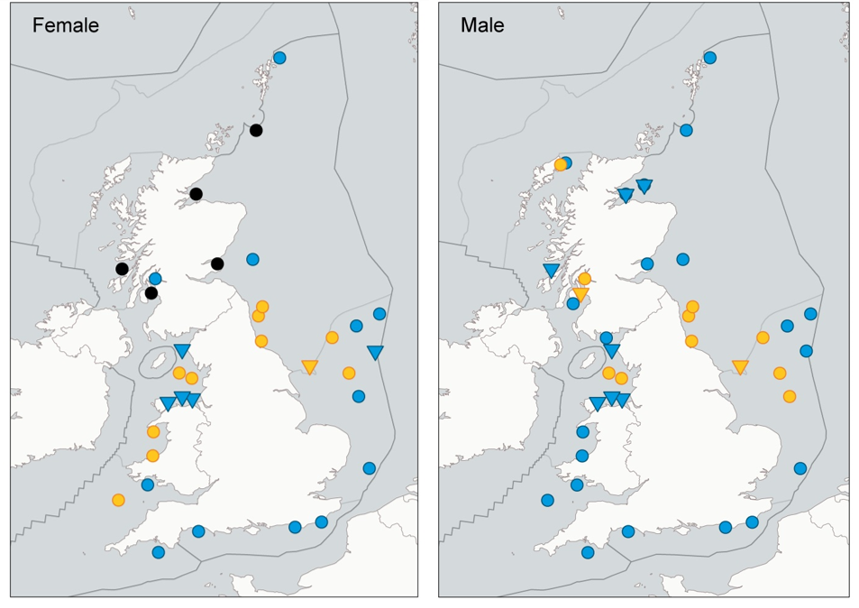
Figure 2. Sampling stations that have passed (blue) and failed (orange) the relevant Background Assessment Criteria for EROD activity. Blue: the mean concentration is significantly (p < 0.05) below the Background Assessment Criteria. Orange: the mean concentration is not significantly (p < 0.05) below the Background Assessment Criteria. Black: there is no Background Assessment Criteria. Downward triangle: the mean concentration is significantly decreasing (p < 0.05).
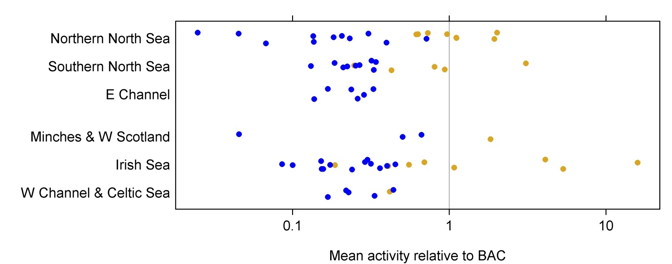
Figure 3. Individual station time series Background Assessment Criteria (BAC) status assessment in 6 of 8 UK biogeographic sub-regions. Blue: the mean concentration is significantly (p < 0.05) below the Background Assessment Criteria. Orange: the mean concentration is not significantly (p < 0.05) below the Background Assessment Criteria.
Trend assessment
Of the 61 time series trend assessments in the Celtic Seas and Greater North Sea, 15 stations (5 in the Greater North Sea and 10 in the Celtic Seas) showed significant downward trends. The rest were stable. Overall, 3 of the 5 assessed biogeographic regions showed a significant downward trend (Northern North Sea, Southern North Sea and the Irish Sea), while the other 2 biogeographic regions were stable (Eastern Channel, and Minches and West Scotland).
Further information
The 7-ethoxy-resorufin-O-deethylase (EROD) enzyme activity was measured in livers of male and female dab, male plaice and male flounder from 34 stations and 61 trend assessments could be carried out. 70 status assessments were carried out at 38 stations. 23 assessments showed how EROD enzyme activity exceeded the Background Assessment Criteria . This is particularly the case in the Northern North Sea, where the 42% of assessments exceed the Background Assessment Criteria for EROD. All stations in the Eastern Channel are below Background Assessment Criteria (Table 3), indicating that flatfish in this region are not significantly exposed to contaminants which induce EROD activity. Some stations in the Northern and Southern North Sea, Western Channel and Celtic Sea, and Minches and Western Scotland showed EROD activities above the Background Assessment Criteria, but overall the areas do not show levels of great concern. This status assessment is supported by the trend assessment (Table 4). No assessments indicate an upward trend. All stations either showed no trend or no significant decreases in EROD activity. Three of the five assessed biogeographic regions show a significant downward trend (Northern North Sea, Southern North Sea and the Irish Sea), while the other two biogeographic regions are stable (Eastern Channel, and Minches and West Scotland). 15 assessments showed significant downward trends (5 in the Greater North Sea and 10 in the Celtic Seas) (Figure 4). The other 46 assessments stayed stable (27 in the Greater North Sea and 19 in the Celtic Seas).
Table 3. Number of time series with each status by biogeographic region and Marine Strategy Framework Directive sub-region. “<BAC”: the mean concentration is significantly (p < 0.05) below the Background Assessment Criteria. “>BAC”: the mean concentration is not significantly (p < 0.05) below the Background Assessment Criteria.
|
Marine Strategy Framework Directive sub-region |
Biogeographic region |
Status assessments |
EROD Stations |
|
Greater North Sea |
Northern North Sea |
< BAC |
11 |
|
> BAC |
8 |
||
|
Southern North Sea |
< BAC |
9 |
|
|
> BAC |
5 |
||
|
E Channel |
< BAC |
6 |
|
|
> BAC |
0 |
||
|
Celtic Seas |
Minches & W Scotland |
< BAC |
3 |
|
o> BAC |
1 |
||
|
Irish Sea |
< BAC |
13 |
|
|
orange |
8 |
||
|
W Channel & Celtic Sea |
< BAC |
5 |
|
|
> BAC |
1 |
Table 4. Number of time series with each trend by biogeographic region and Marine Strategy Framework Directive sub-region.
|
Marine Strategy Framework Directive sub-region |
Biogeographic region |
Trend assessment |
EROD Stations |
|
Greater North Sea |
Northern North Sea |
upward trend |
0 |
|
no trend |
8 |
||
|
downward trend |
4 |
||
|
Southern North Sea |
upward trend |
0 |
|
|
no trend |
13 |
||
|
downward trend |
1 |
||
|
E Channel |
upward trend |
0 |
|
|
no trend |
6 |
||
|
downward trend |
0 |
||
|
Celtic Seas |
Minches & W Scotland |
upward trend |
0 |
|
no trend |
2 |
||
|
downward trend |
1 |
||
|
Irish Sea |
upward trend |
0 |
|
|
no trend |
13 |
||
|
downward trend |
9 |
||
|
W Channel & Celtic Sea |
upward trend |
0 |
|
|
no trend |
4 |
||
|
downward trend |
0 |
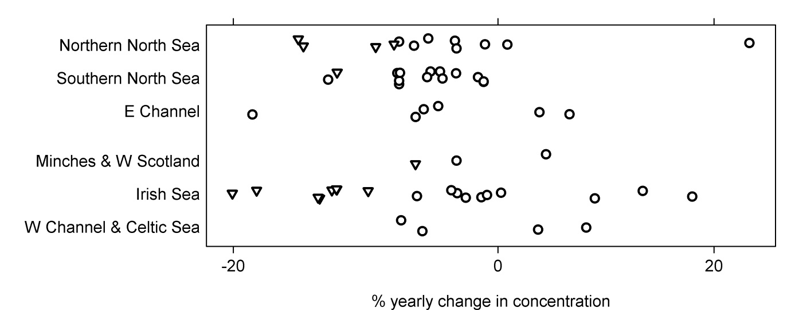
Figure 4. Trends in 6 UK biogeographic sub-regions for which sufficient data are available for trend assessment. 46 stations were static (circles) and 15 showed decreasing trends (downward triangle).
Conclusions
Overall, the Celtic Seas and Greater North Sea sub-region assessments indicate that contaminants in the marine environment do not significantly induce EROD enzyme activity in flatfish. The Northern North Sea followed by the Irish Sea and Southern North Sea biogeographic regions are most at risk from such contaminants with 42%, 38%, and 36%, respectively, of assessments failing the Background Assessment Criteria threshold. This indicates that fish are exposed to contaminants, and increased enzyme activity results from their metabolization. The relatively low concentrations of EROD activity in flatfish, below Environmental Assessment Criteria (OSPAR Commission, 2009) concentrations of polycyclic aromatic hydrocarbon metabolites in fish bile, and of polycyclic aromatic hydrocarbon concentrations in sediments and shellfish, support the argument that flatfish are not exposed to harmful contaminant concentrations in coastal and offshore areas.
Knowledge gaps
During severe exposure to contaminants EROD activity is inhibited. However, levels of exposure are not expected to be high enough to trigger this response, and it would, therefore, be useful to develop Environmental Assessment Criteria to indicate an unacceptable level of response.
Further information
This assessment is based on a good number of offshore stations, but additional near-shore stations would be advantageous to pinpoint inputs and sources of the contaminants causing specific biological effects. Currently no data of EROD enzyme activity of flounder are available from Northern Ireland or near-shore Wales and additional sampling would be advantageous to breach this knowledge gap.
Whilst EROD activity is a non-monotonic response to contaminant exposure, very high exposures are required before toxicity begins to reduce the ability of fish to metabolise contaminants. It would be useful to develop Environmental Assessment Criteria that indicate an unacceptable level of response. If, however, EROD activity is monitored alongside other related indicators (bile metabolites and fish disease) an integrated assessment of potential biological harm can be achieved.
References
Davies IM, Vethaak AD (2012) ‘Integrated marine environmental monitoring of chemicals and their effects’ ICES Cooperative Research Report Number 315, 277 pages (viewed on 16 November 2018)
European Commission (2000) ‘Directive 2000/60/EC of the European Parliament and of the Council establishing a framework for the Community action in the field of water policy’ Official Journal of the European Union L 327, 22122000, pages 1–73 (viewed on 16 November 2018)
European Commission (2008) ‘Directive 2008/56/EC of the European Parliament and of the Council of 17 June 2008 establishing a framework for community action in the field of marine environmental policy (Marine Strategy Framework Directive)’ Official Journal of the European Union L 164, 2562008, pages 19-40 (viewed on 16 November 2018)
Fryer RJ, Nicholson MD (1999) ‘Using smoothers for comprehensive assessments of contaminant time series in marine biota’ ICES Journal of Marine Science, 56:779-790 (viewed on 16 November 2018)
HM Government (2012) ‘Marine Strategy Part One: UK Initial Assessment and Good Environmental Status’ (viewed on 5 July 2018)
HM Government (2015) ‘Marine Strategy Part Three: UK Programme of Measures’ December 2015 (viewed on 5 July 2018)
Hylland K, Burgeot T, Martínez-Gómez C, Lang T, Robinson CD, Svavarsson, J, Thain JE, Vethaak AD, Gubbins, MJ (2017a) ‘How can we quantify impacts of contaminants in marine ecosystems? The ICON project’ Marine Environmental Research 124:2-10 (viewed on 10 December 2018)
Hylland K, Robinson CD, Burgeot T, Martínez-Gómez C, Lang T, Svavarsson J, Thain, JE, Vethaak AD, Gubbins MJ (2017b) ‘Integrated chemical and biological assessment of contaminant impacts in selected European coastal and offshore marine areas’ Marine Environmental Research, 124:130-138 (viewed on 10 December 2018)
ICES (2011) ‘Report of the Joint ICES/OSPAR Study Group on Integrated Monitoring of Contaminants and Biological Effects (SGIMC)’ ICES CM 2011/ACOM:30 REF ACOM, OSPAR (viewed on 10 December 2018)
Nicolaus EEM, Wright SR, Bolam TPC, Barber JL, Bignell JP, Lyons B (2016) ‘Spatial and temporal analysis of the risks posed by polychlorinated biphenyl and metal contaminants in dab (Limanda limanda) collected from waters around England and Wales’ Marine Pollution Bulletin, 112(1-2):399-405 (viewed on 10 December 2018)
OSPAR Commission (2009) ‘Background Document on Assessment Criteria used for assessing CEMP Monitoring Data for the Concentrations of Hazardous Substances in Marine Sediments and Biota in the Context of QSR 2010’ OSPAR Publication 461/2009 ISBN 978-1-907390-08-1 (viewed on 03 December 2018)
OSPAR Commission (2014), ‘OSPAR Joint Assessment and Monitoring Programme (JAMP) 2014 – 2021’ Ospar Agreement 2014-02 (viewed on 27 November 2018)
OSPAR Commission (2016) ‘Trial application of the OSPAR JAMP Integrated Guidelines for the Integrated Monitoring and Assessment of Contaminants’ OSPAR Commission, London, UK (viewed on 10 December 2018)
Robinson, CD, Webster, L, Martínez-Gómez, C, Burgeot, T, Gubbins, MJ, Thain, JE, McIntosh, AD, Vethaak, AD, and Hylland, K (2017) ‘Assessment of contaminant concentrations in sediments, fish and mussels sampled from the North Atlantic and European regional seas within the ICON project’ Marine Environmental Research, 124:21-31 (viewed on 10 December 2018)
Stagg R, McIntosh AD, and Gubbins MJ (2016) ‘Determination of CYP1A dependent mono-oxygenase activity in dab by fluorimetric measurement of EROD activity in S9 or microsomal liver fractions’ ICES Techniques in Marine Sciences number 57 21pp (viewed on 10 December 2018)
UKMMAS (2010) ‘Charting Progress 2: An assessment of the state of the UK seas’ Published by Defra on behalf of the UK Marine Monitoring and Assessment Strategy community (viewed on 4 January 2018)
Vethaak AD, Davies IM, Thain JE, Gubbins MJ, Martínez-Gómez C, Robinson CD, Moffat CF, Burgeot, T, Maes T, Wosniok W, Giltrap M, Lang T, Hylland K (2017) ‘Integrated indicator framework and methodology for monitoring and assessment of hazardous substances and their effects in the marine environment’ Marine Environmental Research, 124:11-20 (viewed on 10 December 2018)
Acknowledgements
Assessment metadata
| Assessment Type | UK Marine Strategy Framework Directive Indicator Assessment |
|---|---|
D8 | |
D8.2 Effects of Contaminants | |
Marine Strategy Part One | |
| Point of contact email | marinestrategy@defra.gov.uk |
| Metadata date | Saturday, September 1, 2018 |
| Title | Biological effects (EROD enzyme activity) in fish |
| Resource abstract | The assessment shows that since 2012, flatfish are exposed to some PAHs, PCBs, furans and dioxins in the Celtic Seas and Greater North Sea Sub-Regions, but these do not induce significant EROD enzyme activity. There is no evidence of systematic exposure at the regional level. Recent trends have been mainly downward or stable. |
| Linkage | In addition to links provided in ‘References’ section above: Wakeling D, Passant NR, Murrells TP, Pang Y, Thistlethwaite G, Walker, C, Garcia JMR, Webb J, Brown P, Del Vento S, Misra A, Hobson M, Pridmore A, Dore C, Misselbrook T (2016) ‘UK Informative Inventory Report (1990 to 2014)’ Defra, London, UK. 237 pages (viewed on 10 January 2018) |
| Conditions applying to access and use | © Crown copyright, licenced under the Open Government Licence (OGL). |
| Assessment Lineage | The 2016 assessment of the UK's Clean Seas Environment Monitoring Programme described the status and trends of contaminant concentrations and biological effects measurements in biota and sediment at monitoring stations in waters around the UK. Assessments were made for a large number of time series, typically each of a single contaminant in a single species (for biota) at a single monitoring station. The results of the individual time series at coastal and offshore stations were synthesised to assess status and trends at the biogeographic regional level and formed the basis of this indicator. Data were submitted to the MERMAN database from relevant Competent Monitoring Authorities. A series of templates were populated by submitting officers and submitted to the database which has in-built data restrictions and a data filter to ensure high quality, accurate data are submitted. The data filter has formulae in-built which use Accredited Quality Control information from known standards, limits, standard deviations and/or inter laboratory calibration exercises to calculate a score. Only data that passed a threshold agreed with the national advisory bodies were used for assessments. The data for 1999 - 2015 were extracted from MERMAN. Further data checks were made and records with obvious errors were deleted or corrected. The data were standardised to agreed units and bases of EROD in a single sex in a single species at a single monitoring. Time series with no data for the period 2010 - 2015 were excluded. The individual time series were assessed for both trends and status. The methods behind the assessments and the individual time series results are available from the British Oceanographic Data Centre. The results of the individual time series at coastal and offshore stations were then synthesised to assess status and trends at the biogeographic regional level. The methods and results are available from the British Oceanographic Data Centre. |
| Dataset metadata | http://portal.oceannet.org/portal/start.php#details?tpc=012_Marine_Scotland_FishDAC_12111 |
| Dataset DOI |
The Metadata are “data about the content, quality, condition, and other characteristics of data” (FGDC Content Standard for Digital Geospatial Metadata Workbook, Ver 2.0, May 1, 2000).
Metadata definitions
Assessment Lineage - description of data sets and method used to obtain the results of the assessment
Dataset – The datasets included in the assessment should be accessible, and reflect the exact copies or versions of the data used in the assessment. This means that if extracts from existing data were modified, filtered, or otherwise altered, then the modified data should be separately accessible, and described by metadata (acknowledging the originators of the raw data).
Dataset metadata – information on the data sources and characteristics of data sets used in the assessment (MEDIN and INSPIRE compliance).
Digital Object Identifier (DOI) – a persistent identifier to provide a link to a dataset (or other resource) on digital networks. Please note that persistent identifiers can be created/minted, even if a dataset is not directly available online.
Indicator assessment metadata – data and information about the content, quality, condition, and other characteristics of an indicator assessment.
MEDIN discovery metadata - a list of standardized information that accompanies a marine dataset and allows other people to find out what the dataset contains, where it was collected and how they can get hold of it.
Recommended reference for this indicator assessment
E.E. Manuel Nicolaus1, Craig D. Robinson2 and Rob Fryer2 2018. Status assessment for biological effects (EROD enzyme activity) in fish. UK Marine Online Assessment Tool, available at: https://moat.cefas.co.uk/pressures-from-human-activities/contaminants/erod/
1Centre for Environment, Fisheries and Aquaculture Science
2Marine Scotland
